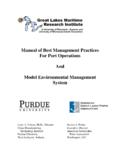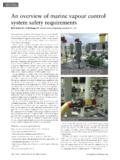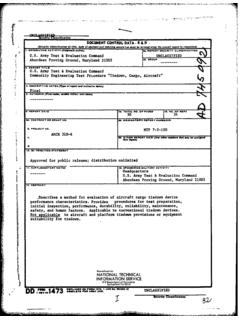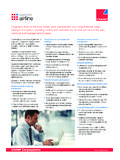Transcription of 3 AIRPORT CARGO OPERATIONS Types of airports
1 25 3 AIRPORT CARGO OPERATIONS Types of airports Nearly all airports handle both CARGO and passengers. There are relatively few pure CARGO airports . For CARGO OPERATIONS , the airports can be categorized as hub and feeder airports , especially for international OPERATIONS where the hub-and-spoke system continues to be the dominant operating model for scheduled flights, both passenger and CARGO . Larger aircraft are used on long-haul international routes, while smaller aircraft serve domestic origins and destinations. This system allows shipments between origin/destination pairs that could not support direct, point-to-point, service.
2 It also provides for more frequent services from the hubs to the various international origins and destinations. The hub AIRPORT is generally located in or near a major population center to have a significant amount of inbound and outbound baseload CARGO . It provides a transshipment node not only for interlining between domestic and international carriers but also for connections between an airline s domestic and international services. A larger hub AIRPORT may also act as regional gateway, for example: Hong Kong, which provides European and North American carriers with air and land access to China, as well as air access to other Asian destinations, Dubai, which provides connections between European and Asian services, also acts as a regional distribution center for Africa and the Middle East.
3 Miami, Florida and Tocumen AIRPORT in Panama, which serve Latin American carriers connecting with North American and European carriers. The hub and spoke system can also be intermodal providing a connection for sea-air services or for sea-road services. The latter involve RFS (road freight s ervices) connections in which an international air movement is combined with a domestic road movement between the hub and feeder AIRPORT . The road transport segment is treated as a scheduled air shipment. The CARGO is transported under an airway bill and customs clearance is performed at the feeder AIRPORT s warehouse.
4 This arrangement allows an airfreight carrier to sell services to airports where it does not actually land. The latter can all ow nearby airports to act as hubs for different carriers, as is the case with Dubai and Abu Dhabi or Beijing and Tianjin. Most of the major hub airports serve either a large integrator or the dominant national carriers as shown in Table 3-1. However, some of the hub airports serve a broad mix of services, for example New York s JFK (Table 3-2). Governments can help airports to achieve the status by improving AIRPORT performance through investment in infrastructure and transfer of OPERATIONS to private operators.
5 Freight forwarders can promote the use of an AIRPORT for international Table 3-1. Hub status of top 15 CARGO airports Rank City 2006 CARGO (000 Tons) Hub Status 1 Memphis 3,692 FedEx 2 Hong Kong 3,610 DHL 3 Anchorage,** 2,691 FedEx 4 Seoul 2,337 KAL 5 Tokyo 2,281 JAL 6 Shanghai 2,168 China Air 7 Paris 2,131 AF-KLM 8 Frankfurt 2,128 Lufthansa 9 Louisville 1,983 UPS 10 Singapore 1,932 Singapore 11 Los Angeles 1,907 Various 12 Miami 1,831 Various 13 Taipei 1,699 China Air, Eva Air 14 New York 1,636 Various 15 Amsterdam 1,567 AF-KLM, Martinair Source: airports Council International 26 AIR FREIGHT.
6 A MARKET STUDY WITH IMPLICATIONS FOR LANDLOCKED COUNTRIES shipments. However, the choice of hub airports remains the purview of the airlines, which choose hub airports in order to optimize their networks. Furthermore, multinational carriers do not have any local obligations beyond adhering to regulatory requirements. The national hubs are usually airports that serve the capital or other major markets and act as a gateway to/from smaller markets within that country. The selection of national hub airports is often determined by government, especially where the national carrier is controlled by the government and required to provide essential air services to outlying markets that are not profitable.
7 The national carrier either provides international services or interlines with a foreign carrier. In rare cases, this relationship can lead to the development of a regional hub but only where there is already a substantial and effective operation. For example, San Salvador evolved from a hub for the national carrier TACA to a regional hub once TACA established itself as Central America s regional carrier by acquiring the former national airlines of Costa Rica, Honduras, Guatemala and Nicaragua. As a regional hub, San Salvador provides shippers and travelers with direct flights to markets that would otherwise have only been served through interlining.
8 In recent years, the growth of large integrators has led to the development of airports in which CARGO is the primary business. Since a certain scale of OPERATIONS is required to justify the investment in an all - CARGO AIRPORT (see discussion at end of chapter), there are relatively few of them and nearly all are located in the United States and Europe. These include FedEx regional hubs in Ft. Worth, Texas (Alliance AIRPORT ) and Columbus, Ohio (Rickenbacker), DHL s hubs in Riverside, California and Wilmington, Ohio and its UK hub at East Midlands.
9 One of the few all- CARGO airports in developing countries is Viracopos AIRPORT in Brazil. There has been talk of setting up a facility in Johore in Malaysia but the profitability remains in question, especially given the proximity to Changi AIRPORT in Singapore. More common are airports in which there is some passenger traffic, but the CARGO OPERATIONS of the integrators are the major activity. Examples in the United States include the FedEx hub in Memphis, Tennessee, and Indianapolis, Indiana, the BAX Global hub in Toledo, Ohio and UPS hubs in Louisville, Kentucky and Ontario, California.
10 In Europe, there is the TNT hub in Liege in Belgium (see Box 3-1), and the DHL hub in Leipzig, Germany, as well as the Cargolux hub in Luxembourg AIRPORT . There are no such hubs in Latin America, as the integrators prefer to operate out of Miami. There is, however, a major CARGO operation in Bogot , Colombia. In the Middle East, there are DHL hubs in Bahrain and Dubai. The latter also serves as the hub for FedEx, Emirates and most of the CARGO airlines serving the region. In East Asia, FedEx and UPS have operated hubs at Subic and Clarke in the Philippines, but have since shifted their OPERATIONS to China, Guangzhou and Shanghai Pudong, 20 There initial attraction had been their location on the main trade route to Southern China and Southeast Asia combined with very low charges and a liberal regulatory policy, but they lost this business when China liberalized its regulations.















